weight CITROEN C3 AIRCROSS 2021 Handbook (in English)
[x] Cancel search | Manufacturer: CITROEN, Model Year: 2021, Model line: C3 AIRCROSS, Model: CITROEN C3 AIRCROSS 2021Pages: 244, PDF Size: 6.29 MB
Page 128 of 244

126
Practical information
– the green mark on the star wheel is in line
with the white mark on the ball joint,
– the locking wheel is in contact with the towball (position A),– the security key lock is on and the key removed; the locking wheel can no longer be
operated,
– the towball must not be able to move in its carrier; test by shaking it with your hand.
If the towball is not locked, the trailer can
detach - accident risk!
During use
Never release the locking system with a
trailer or load carrier on the towball.
Never exceed the maximum authorised
weight for the vehicle - the Gross Train
Weight or GTW.
It is essential that the maximum authorised
load be complied with on the towing device:
if it is exceeded, this device may detach from
the vehicle, which is a serious accident risk.
Check that the trailer lamps work correctly.
Before setting off, check the adjustment of the
headlamp beam height.
For more information on Headlamp
adjustment, refer to the corresponding
section.
Following use
When travelling without a trailer or load
on a towbar-mounted carrier, the towball
must be removed and the protective plug
inserted in the carrier. This measure applies
particularly where the towball might obscure
visibility of the number plate or its lighting.
Fitting the towball
► Below the rear bumper , remove the protective plug 2 from the towball carrier 1.
► Insert the end of towball 5 into carrier 1 and
push it upwards; the locking will take place
automatically.
► The locking wheel 6 turns a quarter of a turn
anti-clockwise ; take care to keep your hands
clear!
► Check that the mechanism has correctly locked into place and that the green mark on the
star wheel is in line with the white mark on the
towball (position A).
► Close the lock 7 using the key.
Page 130 of 244
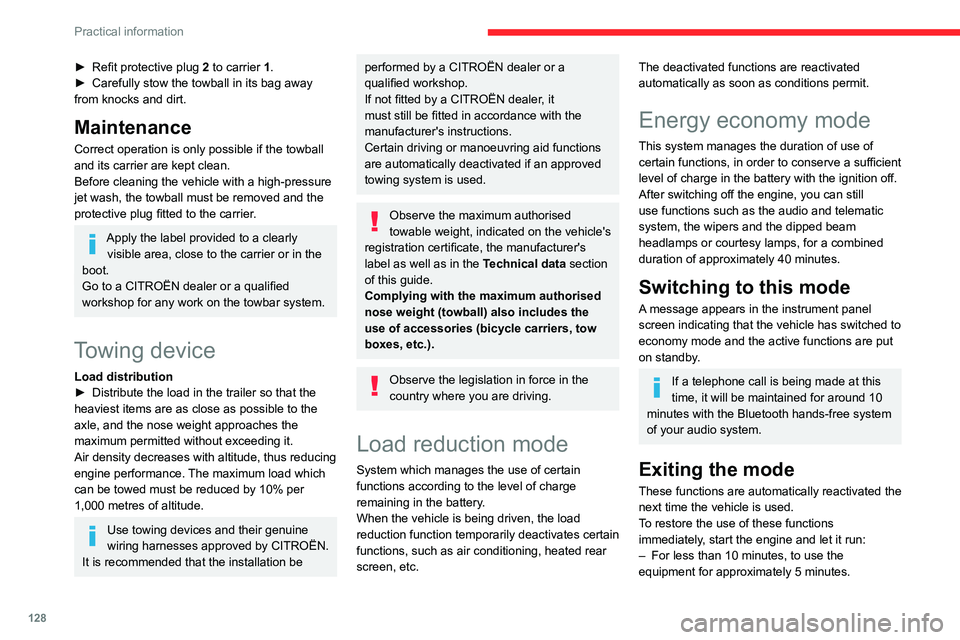
128
Practical information
► Refit protective plug 2 to carrier 1.► Carefully stow the towball in its bag away from knocks and dirt.
Maintenance
Correct operation is only possible if the towball
and its carrier are kept clean.
Before cleaning the vehicle with a high-pressure
jet wash, the towball must be removed and the
protective plug fitted to the carrier.
Apply the label provided to a clearly visible area, close to the carrier or in the
boot.
Go to a CITROËN dealer or a qualified
workshop for any work on the towbar system.
Towing device
Load distribution► Distribute the load in the trailer so that the heaviest items are as close as possible to the
axle, and the nose weight approaches the
maximum permitted without exceeding it.
Air density decreases with altitude, thus reducing
engine performance. The maximum load which
can be towed must be reduced by 10% per
1,000 metres of altitude.
Use towing devices and their genuine
wiring harnesses approved by CITROËN.
It is recommended that the installation be
performed by a CITROËN dealer or a
qualified workshop.
If not fitted by a CITROËN dealer, it
must still be fitted in accordance with the
manufacturer's instructions.
Certain driving or manoeuvring aid functions
are automatically deactivated if an approved
towing system is used.
Observe the maximum authorised
towable weight, indicated on the vehicle's
registration certificate, the manufacturer's
label as well as in the Technical data section
of this guide.
Complying with the maximum authorised
nose weight (towball) also includes the
use of accessories (bicycle carriers, tow
boxes, etc.).
Observe the legislation in force in the
country where you are driving.
Load reduction mode
System which manages the use of certain
functions according to the level of charge
remaining in the battery.
When the vehicle is being driven, the load
reduction function temporarily deactivates certain
functions, such as air conditioning, heated rear
screen, etc.
The deactivated functions are reactivated
automatically as soon as conditions permit.
Energy economy mode
This system manages the duration of use of
certain functions, in order to conserve a sufficient
level of charge in the battery with the ignition off.
After switching off the engine, you can still
use functions such as the audio and telematic
system, the wipers and the dipped beam
headlamps or courtesy lamps, for a combined
duration of approximately 40 minutes.
Switching to this mode
A message appears in the instrument panel
screen indicating that the vehicle has switched to
economy mode and the active functions are put
on standby.
If a telephone call is being made at this
time, it will be maintained for around 10
minutes with the Bluetooth hands-free system
of your audio system.
Exiting the mode
These functions are automatically reactivated the
next time the vehicle is used.
To restore the use of these functions
immediately, start the engine and let it run:
– For less than 10 minutes, to use the equipment for approximately 5 minutes.
– For more than 10 minutes, to use the equipment for approximately 30 minutes.
Let the engine run for the specified duration to
ensure that the battery charge is sufficient.
To recharge the battery, avoid repeatedly or
continuously restarting the engine.
A flat battery prevents the engine from
starting.
For more information on the
12 V battery,
refer to the corresponding section.
Roof bars
For safety reasons and to avoid
damaging the roof, it is essential to use
the transverse bars approved for your vehicle.
Observe the fitting instructions and the
conditions of use in the guide supplied
with the roof bars.
Page 158 of 244

156
In the event of a breakdown
Accessing the tools
The tools are located in the boot. Depending
on version, they are stored under the floor or
behind the removable grille of the right-hand
compartment.
For access:
► Open the boot.► Then, depending on version, lift up the floor using the handle, remove it and remove the mat.► Or open the removable grille on the right by pulling from the top.
For more information on the list of tools, refer to
the Tool kit section.
Towing
Procedure for having your vehicle towed or for towing another vehicle using the towing eye.
General recommendations
Observe the legislation in force in the country where you are driving.
Ensure that the weight of the towing vehicle is higher than that of the towed vehicle.
The driver must remain at the wheel of the towed vehicle and must have a valid driving licence.
When towing a vehicle with all four wheels on the ground, always use an approved towbar; ropes and straps are prohibited.
The towing vehicle must move off gently.
When the vehicle is towed with its engine off, there is no longer braking and steering assistance.
A professional recovery service must be called if:– broken down on a motorway or main road;– not possible to put the gearbox into neutral, unlock the steering, or release the parking brake;– not possible to tow a vehicle with an automatic gearbox, with the engine running;– towing with only two wheels on the ground;– four-wheel drive vehicle;– no approved towbar available.
Towing constraints
Type of vehicle
(engine / gearbox)gearbox Font wheels on the
groundRear wheels on the
groundFlatbed
4 wheels on the ground
with towbar
Internal combustion /
Manual
Internal combustion /
Automatic
In case of battery or electric parking brake failure, it is essential to call a p
rofessional using flatbed recovery vehicles (excluding manual gearbox).
Page 160 of 244

158
Technical data
Engine technical data and
towed loads
Engines
The engine specifications (capacity, max. power,
max. speed, energy, CO
2 emissions, etc.)
associated with your vehicle are indicated on
the registration document, as well as in sales
brochures.
These characteristics correspond to the values
type-approved on a test bed, under conditions
defined in European legislation (Directive
1999/99/EC).
For more information, contact a CITROËN dealer
or a qualified workshop.
Weights and towed loads
The weights and towed loads relating to
your vehicle are indicated on the registration
document, as well as in sales brochures.
These values are also indicated on the
manufacturer's plate or label.
For more information, contact a CITROËN dealer
or a qualified workshop.
The GTW values and the towed loads listed are
valid for a maximum altitude of 1,000 metres.
The towed load must be reduced by steps of
10% for each additional 1,000 metres.
The maximum authorised nose weight
corresponds to the weight permitted on the
towball.
GTW: Gross train weight.
When exterior temperatures are high, the
vehicle performance may be limited in
order to protect the engine. When the exterior
temperature is higher than 37°C, limit the
towed weight.
Towing using a lightly loaded vehicle can adversely affect roadholding.
Braking distances are increased when towing
a trailer.
When using a vehicle to tow, never exceed a
speed of approximately 60 mph (100 km/h)
(observe the local legislation in force).
If the exterior temperature is high, it is
recommended that the engine is allowed
to idle for 1 to 2 minutes after the vehicle
comes to a stop, to facilitate its cooling.
Engines and towed loads - PETROL
Engine PureTech 110 S&SPureTech 110 S&S
Gearbox Manual 5-speed
(BVM5)Automatic
6-speed (EAT6)Manual 6-speed
(BVM6)Automatic
6-speed (EAT6)Manual 6-speed
(BVM6)
Code EB2DT
(Euro 6.1)EB2ADT(Euro 6.2)EB2ADT(Euro 6.3)
Model codes: 2R...HNZBHNZWHNPJHNPXHNPM
Cubic capacity (cm
3) 1,1991,1991,1991,1991,199
Max. power: EC standard (kW) 8181818181
Fuel UnleadedUnleadedUnleadedUnleadedUnleaded
Braked trailer (within the GTW limit) on a
10 or 12% slope (kg) 840
840840840840
Unbraked trailer (kg) 600600600600600
Maximum authorised nose weight (kg) 6565656565
Page 161 of 244
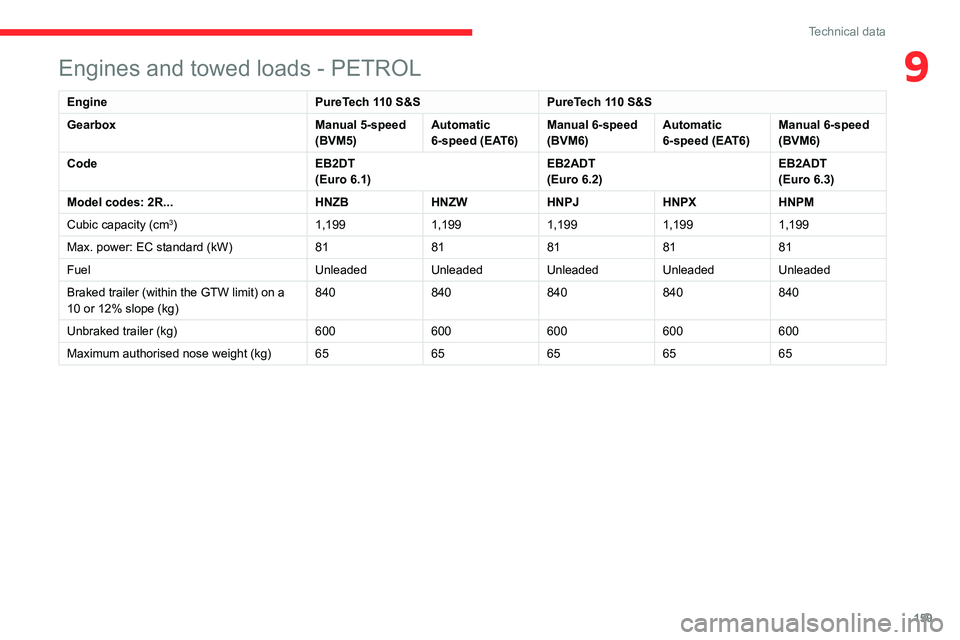
159
Technical data
9Engines and towed loads - PETROL
EnginePureTech 110 S&SPureTech 110 S&S
Gearbox Manual 5-speed
(BVM5)Automatic
6-speed (EAT6)Manual 6-speed
(BVM6)Automatic
6-speed (EAT6)Manual 6-speed
(BVM6)
Code EB2DT
(Euro 6.1)EB2ADT(Euro 6.2)EB2ADT(Euro 6.3)
Model codes: 2R...HNZBHNZWHNPJHNPXHNPM
Cubic capacity (cm
3) 1,1991,1991,1991,1991,199
Max. power: EC standard (kW) 8181818181
Fuel UnleadedUnleadedUnleadedUnleadedUnleaded
Braked trailer (within the GTW limit) on a
10 or 12% slope (kg) 840
840840840840
Unbraked trailer (kg) 600600600600600
Maximum authorised nose weight (kg) 6565656565
Page 162 of 244
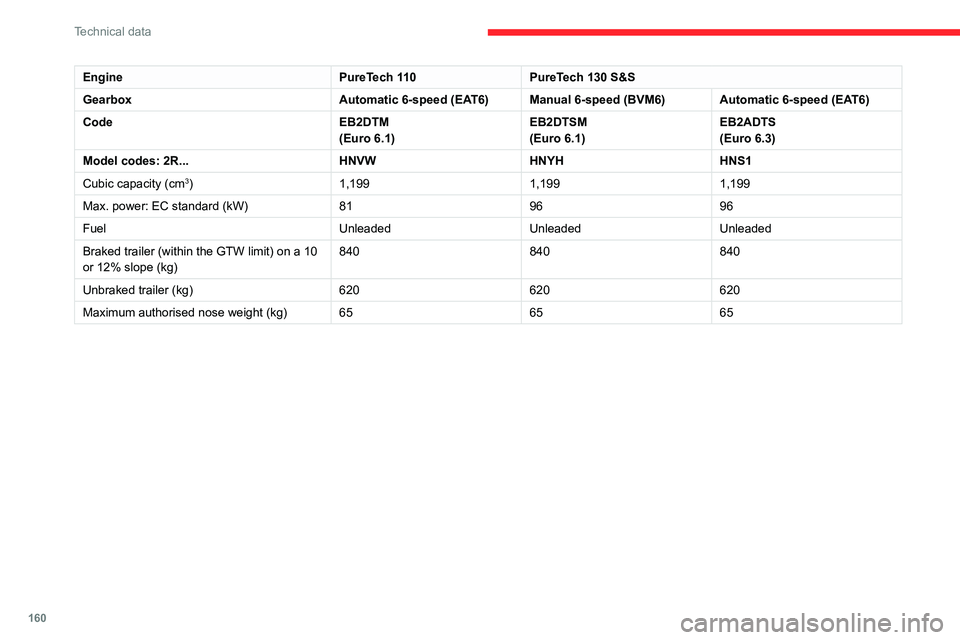
160
Technical data
EnginePureTech 110PureTech 130 S&S
Gearbox Automatic 6-speed (EAT6)Manual 6-speed (BVM6)Automatic 6-speed (EAT6)
Code EB2DTM
(Euro 6.1)EB2DTSM(Euro 6.1)EB2ADTS(Euro 6.3)
Model codes: 2R...HNVWHNYHHNS1
Cubic capacity (cm
3) 1,199 1,1991,199
Max. power: EC standard (kW) 819696
Fuel UnleadedUnleadedUnleaded
Braked trailer (within the GTW limit) on a 10
or 12% slope (kg) 840
840840
Unbraked trailer (kg) 620620620
Maximum authorised nose weight (kg) 656565
Engines and towed loads - DIESEL
Engine HDi 92BlueHDi 100 S&S BlueHDi 120 S&S
Gearbox Manual 5-speed
(BVM5)Manual 6-speed
(BVM6)Manual 6-speed
(BVM6)Automatic 6-speed (EAT6)
Code DV6D
(Euro 5)DV5RD(Euro 6.2)DV5RCe(Euro 6.3)DV5RCD(Euro 6.2)DV5RCD(Euro 6.3)
Model codes: 2C...9HPAYHYJYHSMYHXXYHX1
Cubic capacity (cc) 1,5601,499-1,499-
Max. power: EC standard (kW) 6875-88-
Fuel DieselDieselDieselDiesel-
Braked trailer (within the GTW limit) on a
10 or 12% slope (kg) 840
840-
870 / 0*-
Unbraked trailer (kg) 610620-
650 / 0*-
Maximum authorised nose weight (kg) 6565-55-
* Vehicles with sunroof or spare wheel.
Page 163 of 244
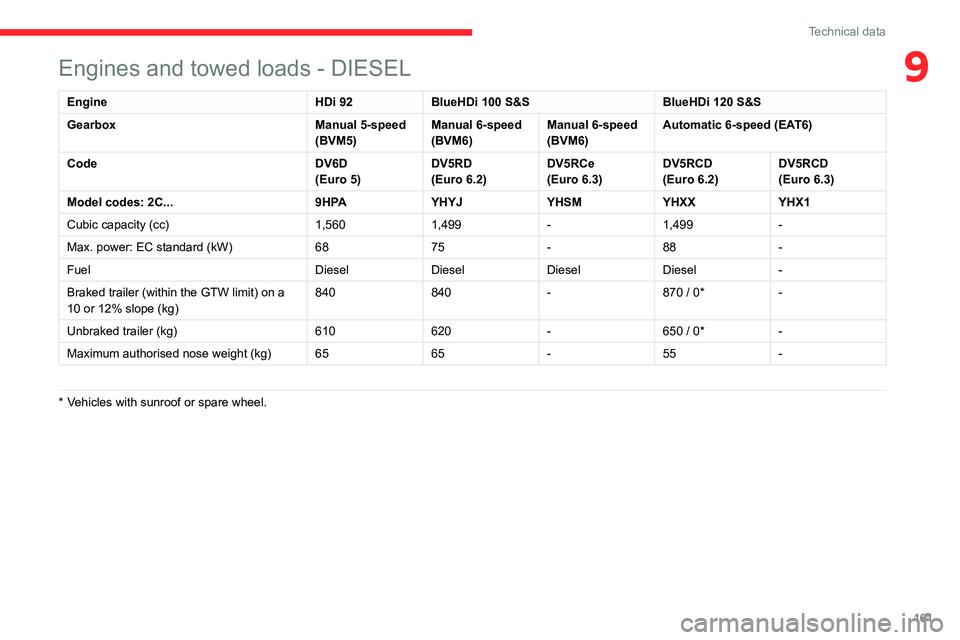
161
Technical data
9Engines and towed loads - DIESEL
Engine HDi 92BlueHDi 100 S&S BlueHDi 120 S&S
Gearbox Manual 5-speed
(BVM5)Manual 6-speed
(BVM6)Manual 6-speed
(BVM6)Automatic 6-speed (EAT6)
Code DV6D
(Euro 5)DV5RD(Euro 6.2)DV5RCe(Euro 6.3)DV5RCD(Euro 6.2)DV5RCD(Euro 6.3)
Model codes: 2C...9HPAYHYJYHSMYHXXYHX1
Cubic capacity (cc) 1,5601,499-1,499-
Max. power: EC standard (kW) 6875-88-
Fuel DieselDieselDieselDiesel-
Braked trailer (within the GTW limit) on a
10 or 12% slope (kg) 840
840-
870 / 0*-
Unbraked trailer (kg) 610620-
650 / 0*-
Maximum authorised nose weight (kg) 6565-55-
* Vehicles with sunroof or spare wheel.
Page 164 of 244
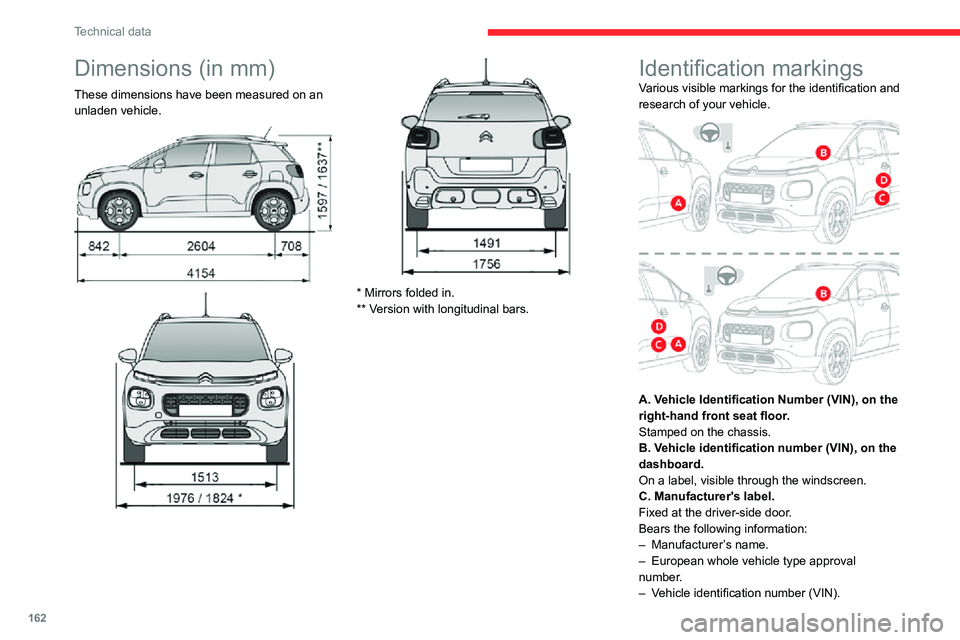
162
Technical data
– Gross vehicle weight (GVW).– Gross train weight (GTW).– Maximum weight on the front axle.– Maximum weight on the rear axle.D. Tyres label.
Fixed at the driver-side door.
Bears the following information about the tyres:
– tyre pressures, unladen and laden.– tyre specification, made up of the dimensions and type as well as the load and speed indices.– spare tyre inflation pressure.
The vehicle may be originally equipped
with tyres with higher load and speed
indices than those indicated on the label,
without affecting tyre pressure (on cold tyres).
Dimensions (in mm)
These dimensions have been measured on an
unladen vehicle.
* Mirrors folded in.
** Version with longitudinal bars.
Identification markingsVarious visible markings for the identification and
research of your vehicle.
A. Vehicle Identification Number (VIN), on the
right-hand front seat floor.
Stamped on the chassis.
B. Vehicle identification number (VIN), on the
dashboard.
On a label, visible through the windscreen.
C. Manufacturer's label.
Fixed at the driver-side door.
Bears the following information:
– Manufacturer ’s name.– European whole vehicle type approval number.
– Vehicle identification number (VIN).
Page 165 of 244
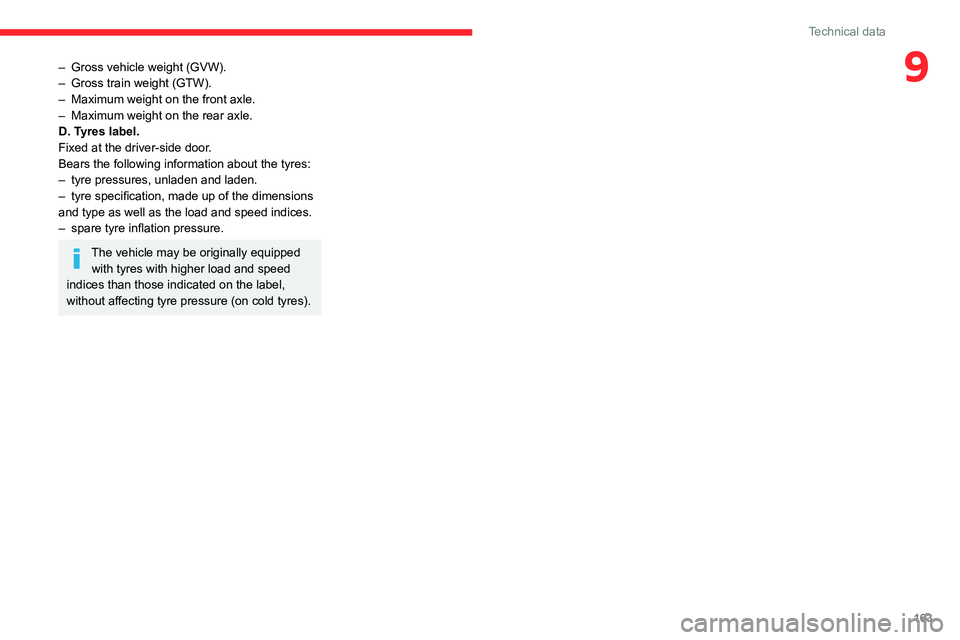
163
Technical data
9– Gross vehicle weight (GVW).– Gross train weight (GTW).– Maximum weight on the front axle.– Maximum weight on the rear axle.D. Tyres label.
Fixed at the driver-side door.
Bears the following information about the tyres:
– tyre pressures, unladen and laden.– tyre specification, made up of the dimensions and type as well as the load and speed indices.– spare tyre inflation pressure.
The vehicle may be originally equipped
with tyres with higher load and speed
indices than those indicated on the label,
without affecting tyre pressure (on cold tyres).
Page 221 of 244
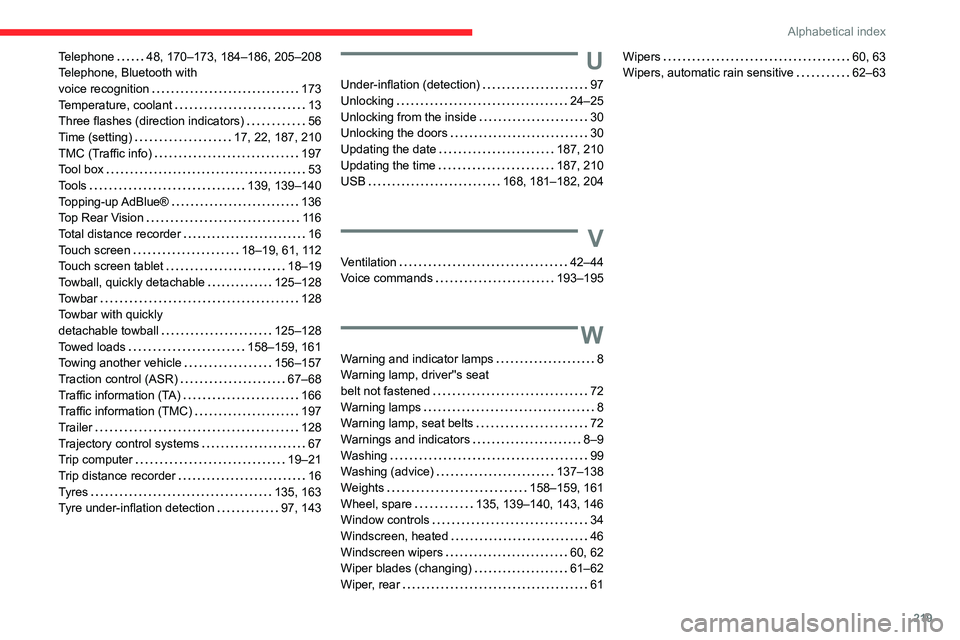
219
Alphabetical index
Telephone 48, 170–173, 184–186, 205–208Telephone, Bluetooth with voice recognition 173Temperature, coolant 13Three flashes (direction indicators) 56Time (setting) 17, 22, 187, 210TMC (Traffic info) 197Tool box 53Tools 139, 139–140Topping-up AdBlue® 136Top Rear Vision 11 6Total distance recorder 16Touch screen 18–19, 61, 112Touch screen tablet 18–19Towball, quickly detachable 125–128Towbar 128Towbar with quickly detachable towball 125–128Towed loads 158–159, 161Towing another vehicle 156–157Traction control (ASR) 67–68Traffic information (TA) 166Traffic information (TMC) 197Trailer 128Trajectory control systems 67Trip computer 19–21Trip distance recorder 16Tyres 135, 163Tyre under-inflation detection 97, 143
U
Under-inflation (detection) 97Unlocking 24–25Unlocking from the inside 30Unlocking the doors 30Updating the date 187, 210Updating the time 187, 210USB 168, 181–182, 204
V
Ventilation 42–44Voice commands 193–195
W
Warning and indicator lamps 8Warning lamp, driver''s seat belt not fastened 72Warning lamps 8Warning lamp, seat belts 72Warnings and indicators 8–9Washing 99Washing (advice) 137–138Weights 158–159, 161Wheel, spare 135, 139–140, 143, 146Window controls 34
Windscreen, heated 46Windscreen wipers 60, 62Wiper blades (changing) 61–62Wiper, rear 61
Wipers 60, 63Wipers, automatic rain sensitive 62–63